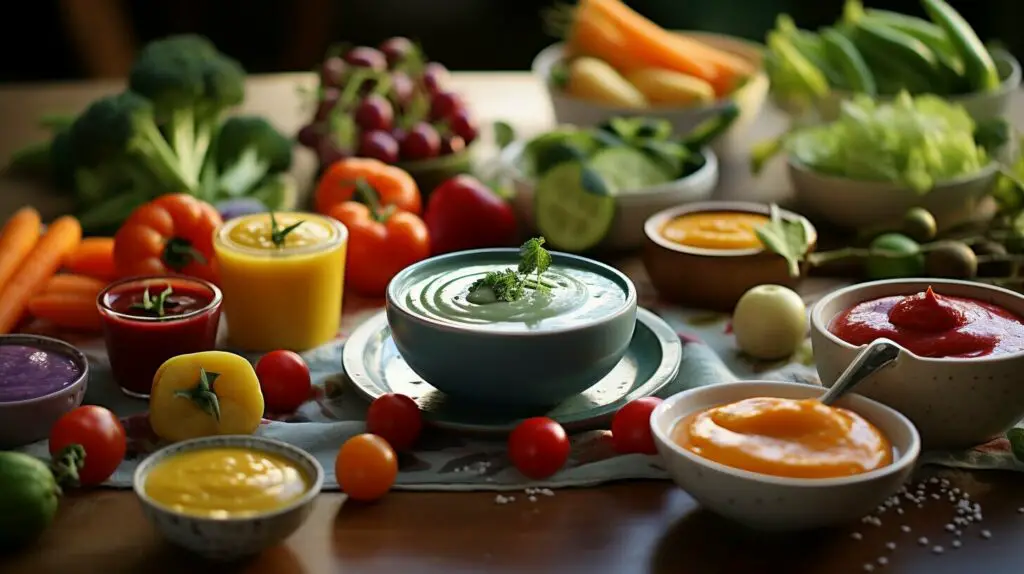As a parent, you always want your little one to be healthy and comfortable. However, despite your best efforts, diaper rash can sometimes occur. While there are several factors that can contribute to diaper rash, one possible culprit may be your baby’s diet.
In this article, we will dive into the relationship between baby food and diaper rash. We will explore whether certain foods can cause diaper rash in infants and discuss possible prevention and treatment options.
Key Takeaways:
- Introducing solid foods to your baby’s diet can potentially increase the risk of diaper rash.
- Some ingredients in baby food can cause skin irritation and lead to diaper rash.
- Choosing the right baby foods and incorporating a variety of nutritious options can help prevent diaper rash.
- Effective treatment options for diaper rash linked to diet include diaper creams containing zinc oxide.
- While baby food can contribute to diaper rash, other factors should also be considered and addressed for optimal prevention and treatment.

Understanding Diaper Rash and its Causes
When it comes to your baby’s delicate skin, diaper rash can be a common and uncomfortable issue. Diaper rash is a form of skin irritation that occurs in the diaper area of infants, typically appearing as red, swollen, and sore patches.
There can be several causes of diaper rash, including prolonged exposure to moisture, friction, and certain skin products. However, the primary cause of diaper rash is due to prolonged contact with urine and feces, which can irritate the skin and lead to inflammation.
Common Causes of Diaper Rash
| Cause | Description |
|---|---|
| Moisture | Prolonged exposure to wetness caused by urine or sweat can irritate the skin in the diaper area. |
| Friction | Repeated rubbing or chafing of the skin can cause redness and irritation. |
| Products | Certain soaps, wipes, and diaper creams may contain ingredients that irritate the skin. |
| Bacteria or Yeast | Overgrowth of bacteria or yeast in the diaper area can cause diaper rash. |
It’s important to note that in some cases, certain foods may contribute to diaper rash in infants. We will explore this in more detail in later sections.
If you notice your baby exhibiting symptoms of diaper rash, such as redness, inflammation, and discomfort, it’s important to take action to soothe and heal their skin. Effective treatment options include keeping the area clean and dry, applying diaper creams containing zinc oxide, and changing diapers frequently.
“Prevention is key when it comes to diaper rash. Understanding the causes and taking steps to avoid prolonged skin irritations can help keep your baby’s skin healthy.”
Introducing Solid Foods to Your Baby’s Diet
Congratulations on your baby’s milestone of starting solid foods! It’s an exciting time, but it’s essential to consider the impact of introducing new foods on their skin. While optimal nutrition is critical, you must also take care of your baby’s delicate skin.
Before delving into the effects of solid foods on diaper rash, let’s highlight some essential aspects of introducing solid foods to your baby’s diet. Firstly, it’s recommended to wait until around six months of age before starting solids. This delay allows your baby’s digestive system to mature and reduces the risk of allergies. However, you should consult with your pediatrician to determine when your baby is ready to start solids.
When introducing solids, start with simple, single-ingredient foods such as iron-fortified cereals, pureed fruits, and vegetables. Introduce new foods one at a time, observing any reactions before combining with other foods. Remember to keep breastfeeding or formula milk as the primary source of nutrition.
Introducing Solid Foods Safely
Here are some additional tips for introducing solid foods safely:
- Always wash your hands and equipment thoroughly before preparing food.
- Ensure that the food is the right temperature- not too hot or too cold.
- Only introduce finger foods when your baby is ready to self-feed, typically around eight to ten months.
- Never leave your baby unattended while eating and avoid distractions such as television or phones.
Choosing the Right Foods for Healthy Skin
When selecting foods to feed your baby, consider their impact on their skin. Opt for nutrient-rich foods such as fruits, vegetables, lean proteins, and whole grains. These foods can help support healthy skin and minimize the risk of diaper rash. Additionally, water-rich foods such as melons, cucumbers, and strawberries can help keep your baby hydrated, promoting healthy skin.
It’s also crucial to avoid potential skin irritants such as spicy or acidic foods. Keep in mind that highly processed or sugary foods may impact your baby’s overall health, leading to skin issues. Ensure to read food labels carefully and avoid any foods containing artificial flavors, colors, or preservatives.
Potential Triggers in Baby Food
While a healthy and varied diet is essential for your baby’s growth and development, certain ingredients in baby food may contribute to diaper rash. Here are some potential triggers to be mindful of:
| Ingredient | Possible Effect |
|---|---|
| Spices and seasonings | May cause skin irritation or allergies. |
| Acidic fruits and vegetables | May increase the acidity of your baby’s stool, leading to diaper rash. |
| Highly processed foods | May contain additives or preservatives that can irritate your baby’s skin. |
| Dairy products | Some babies may be sensitive or allergic to lactose or milk proteins, leading to diaper rash. |
It’s important to note that every baby is unique, and what may trigger diaper rash in one may not affect another. If you suspect a particular food is causing your baby’s discomfort, speak with your pediatrician for guidance.
Preventing Diaper Rash Through Diet
Preventing diaper rash through diet is one of the most effective ways to keep your baby’s skin healthy and rash-free. By selecting the right baby foods and incorporating a variety of nutritious options, you can minimize the risk of skin irritation. Here are some tips to help:
- Choose the right baby foods: When selecting baby foods, pay attention to the ingredients list. Avoid foods with artificial flavors, colors, and preservatives. Opt for organic, pureed baby foods instead.
- Incorporate a variety of foods: To support healthy skin, it’s essential to provide your baby with a range of nutrients. Offer a mix of protein, vegetables, fruits, and grains.
- Introduce new foods gradually: When starting new foods, introduce them one at a time. This way, you can monitor your baby’s reaction and identify potential triggers.
Additionally, keep in mind that breast milk can also be an essential part of your baby’s diet. Breast milk contains numerous vitamins and nutrients that can help prevent diaper rash.
If you’re concerned that your baby may be reacting poorly to certain foods, talk to your pediatrician. They can help identify potential triggers and recommend the best course of action to keep your baby’s skin healthy.
Treating Diaper Rash Linked to Diet
If your baby develops diaper rash due to their diet, there are several steps you can take to provide effective treatment.
The first step is to switch to a diet of bland, easily-digestible foods such as bananas, rice cereal, and applesauce. These foods are less likely to cause irritation and can help soothe your baby’s skin.
In addition, you can apply a diaper cream containing zinc oxide to your baby’s bottom. Zinc oxide helps to create a barrier on the skin, protecting it from further irritation and promoting healing.
Pro Tip: When applying diaper cream, make sure to completely cover the affected area and apply a thick layer.
You can also give your baby a warm bath with baking soda or colloidal oatmeal to help soothe their skin. After the bath, gently pat your baby dry and apply diaper cream.
If your baby’s diaper rash persists or worsens, it’s important to consult with your pediatrician. They may recommend an over-the-counter cream or prescribe a prescription-strength medication to help clear up the rash.
Remember, diaper rash linked to diet can be uncomfortable and painful for your baby, but with the right treatment, you can help soothe their skin and prevent further irritation.
Other Factors Contributing to Diaper Rash
While it’s important to consider the impact of baby food on diaper rash, there are other factors that may also contribute to this common skin irritation. Understanding these additional causes can help you take preventative measures and provide effective treatment for your baby.
Friction
One of the most common causes of diaper rash is friction. When a diaper constantly rubs against your baby’s delicate skin, it can cause irritation and redness. This is often seen in areas where the diaper fits snugly, such as the waist or thigh areas.
To prevent diaper rash from friction, make sure that your baby’s diaper fits appropriately and isn’t too tight. You can also try using abrasive-free wipes and applying a diaper cream containing zinc oxide or petroleum jelly to create a barrier between the skin and the diaper.
Wetness
Another factor that can contribute to diaper rash is wetness. When a diaper is wet or soiled, it can create an environment that irritates your baby’s skin and leads to a rash. This is especially true if the diaper isn’t changed regularly.
To prevent diaper rash caused by wetness, make sure to change your baby’s diaper frequently, especially after they’ve had a bowel movement. You can also use absorbent diapers and add a diaper liner to help keep your baby’s skin dry and prevent irritation.
Sensitivity
Some babies are simply more prone to diaper rash than others due to their skin’s sensitivity. This can be exacerbated by certain ingredients in baby products, such as fragrances, which can cause irritation.
If your baby is prone to diaper rash, consider using fragrance-free, hypoallergenic products and avoiding harsh chemicals. You can also try giving your baby some diaper-free time each day to allow their skin to breathe and stay dry.
By taking these factors into account, along with the impact of baby food on diaper rash, you can help keep your baby’s skin healthy and rash-free. Remember to monitor your baby’s skin regularly and consult a healthcare professional if you have any concerns.
Conclusion
Introducing your baby to solid foods is an exciting milestone, but it’s important to be mindful of how changes in their diet can affect their skin. While baby food may contribute to diaper rash, there are steps you can take to prevent and treat it.
Remember to always choose baby foods with minimal ingredients and steer clear of potential irritants. If your baby does develop diaper rash, use diaper creams containing zinc oxide to help soothe and heal their skin. And don’t forget to consider other factors that may contribute to diaper rash, such as moisture, friction, and skin sensitivity.
By taking these preventive measures and utilizing appropriate treatments, you can help keep your baby’s skin healthy and rash-free. Here’s to happy feeding and happy babies!




